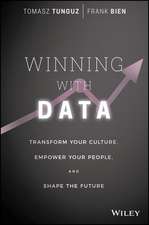Modern Credit Risk Management: Theory and Practice
Autor Panayiota Koulafetisen Limba Engleză Hardback – 17 feb 2017
The book discusses the various quantitative techniques used to assess and manage credit risk, including methods to estimate default probabilities, credit value at risk approaches and credit exposure analysis. Basel I, II and III are covered, as are the true meaning of credit ratings, how these are assigned, their limitations, the drivers of downgrades and upgrades, and how credit ratings should be used in practise is explained.
Modern Credit Risk Management not only discusses credit risk from a quantitative angle but further explains how important the qualitative and legal assessment is. Credit risk transfer and mitigation techniques and tools are explained, as are netting, ISDA master agreements, centralised counterparty clearing, margin collateral, overcollateralization, covenants and events of default. Credit derivatives are also explained, as are Total Return Swaps (TRS), Credit Linked Notes (CLN) and Credit Default Swaps (CDS). Furthermore, the author discusses what we have learned from the financial crisis of 2007 and sovereign crisis of 2010 and how credit risk management has evolved. Finally the book examines the new regulatory environment, looking beyond Basel to the European Union (EU) Capital Requirements Regulation and Directive (CRR-CRD) IV, the Dodd–Frank Wall Street Reform and Consumer Protection Act. This book is a fully up to date resource for credit risk practitioners and academics everywhere, outlining the latest best practices and providing both quantitative and qualitative insights. It will prove a must-have reference for the field.
Preț: 581.82 lei
Preț vechi: 653.73 lei
-11% Nou
Puncte Express: 873
Preț estimativ în valută:
111.34€ • 120.90$ • 93.53£
111.34€ • 120.90$ • 93.53£
Carte disponibilă
Livrare economică 01-15 aprilie
Preluare comenzi: 021 569.72.76
Specificații
ISBN-13: 9781137524065
ISBN-10: 1137524065
Pagini: 272
Ilustrații: XVII, 234 p. 28 illus.
Dimensiuni: 155 x 235 x 22 mm
Greutate: 0.5 kg
Ediția:1st ed. 2017
Editura: Palgrave Macmillan UK
Colecția Palgrave Macmillan
Locul publicării:London, United Kingdom
ISBN-10: 1137524065
Pagini: 272
Ilustrații: XVII, 234 p. 28 illus.
Dimensiuni: 155 x 235 x 22 mm
Greutate: 0.5 kg
Ediția:1st ed. 2017
Editura: Palgrave Macmillan UK
Colecția Palgrave Macmillan
Locul publicării:London, United Kingdom
Cuprins
1. Introduction.- 2. Quantitative Credit Risk Analysis and Management.- 3. Credit Ratings.- Chapter 4. Credit Risk Assessment of Sovereigns, Banks and Corporates.- 5. Credit Risk Assessment of Structured Finance Securities.- 6. Qualitative Credit Risk Analysis and Management.- 7. Credit Risk Transfer and Mitigation.- 8. Regulation.-
Notă biografică
Dr. Panayiota Koulafetis has held a number of positions in the Investment Banking, Asset Management, Rating Agency and Energy Trading Sectors. At Moody’s Investors Service Ltd she led rating analysis and provided surveillance on a wide range of Structured Finance transactions across different jurisdictions: Commercial Mortgage Backed Securities (CMBS), Asset Backed Securities (ABS), Residential Mortgage Backed Securities (RMBS), Whole Business transactions/Corporate Securitisation, Small Medium Enterprises (SMEs) and Lease transactions. At the Securitization department of Nomura International plc she dealt with various transactions across different asset classes. She was also a Senior Structurer at Duke Energy, structuring mainly Energy Derivatives and dealing with complex option structures. She has also held Quantitative Research and Risk Management roles at Westdeutsche Landesbank (WestLB) Asset Management Ltd and Southern Company. Dr. Koulafetis is a regular speaker at academic and industry conferences and has published in academic journals and practitioner periodicals. She holds a PhD in Finance from Cass Business School, City University of London, an MSc in Business Finance from Brunel University and a BSc (Hons) in Business Administration from University of Piraeus in Greece. Dr. Koulafetis works as a consultant and also lectures at the School of Economics and Finance at Queen Mary University of London and at the School of Management and Business at King’s College London.
Textul de pe ultima copertă
Modern Credit Risk Management: From Theory to Practice is a practical guide to the latest risk management tools and techniques applied in the market to assess and manage credit risks at bank, sovereign, corporate and structured finance level. It strongly advocates the importance of sound credit risk management and how this can be achieved with prudent origination, credit risk policies, approval process, setting of meaningful limits and underwriting criteria.
The book discusses the various quantitative techniques used to assess and manage credit risk, including methods to estimate default probabilities, credit value at risk approaches and credit exposure analysis. Basel I, II and III are covered, as are the true meaning of credit ratings, how these are assigned, their limitations, the drivers of downgrades and upgrades, and how credit ratings should be used in practise is explained.
Modern Credit Risk Management not only discusses credit risk from a quantitative angle but further explains how important the qualitative and legal assessment is. Credit risk transfer and mitigation techniques and tools are explained, netting, ISDA master agreement, schedule and CSA, centralised counterparty clearing and margin collateral are all covered, as are overcollateralization, covenants and events of default. Credit derivatives are also explained, Total Return Swaps (TRS), Credit Linked Notes (CLN) and Credit Default Swaps (CDS). Furthermore, the author discusses what we have learned from the financial crisis of 2007 and sovereign crisis of 2010 and how credit risk management has evolved. Finally the book looks at the new regulatory environment, looking beyond Basel to the European Union (EU) Capital Requirements Regulation and Directive (CRR-CRD) IV, the Dodd–Frank Wall Street Reform and Consumer Protection Act.
This book presents a fully up to date resource for credit risk practitioners everywhere, outlining thelatest best practices, and providing both quantitative and qualitative insights. It will be a welcome addition to any risk library, and is a "must-have" reference for credit risk practitioners.
The book discusses the various quantitative techniques used to assess and manage credit risk, including methods to estimate default probabilities, credit value at risk approaches and credit exposure analysis. Basel I, II and III are covered, as are the true meaning of credit ratings, how these are assigned, their limitations, the drivers of downgrades and upgrades, and how credit ratings should be used in practise is explained.
Modern Credit Risk Management not only discusses credit risk from a quantitative angle but further explains how important the qualitative and legal assessment is. Credit risk transfer and mitigation techniques and tools are explained, netting, ISDA master agreement, schedule and CSA, centralised counterparty clearing and margin collateral are all covered, as are overcollateralization, covenants and events of default. Credit derivatives are also explained, Total Return Swaps (TRS), Credit Linked Notes (CLN) and Credit Default Swaps (CDS). Furthermore, the author discusses what we have learned from the financial crisis of 2007 and sovereign crisis of 2010 and how credit risk management has evolved. Finally the book looks at the new regulatory environment, looking beyond Basel to the European Union (EU) Capital Requirements Regulation and Directive (CRR-CRD) IV, the Dodd–Frank Wall Street Reform and Consumer Protection Act.
This book presents a fully up to date resource for credit risk practitioners everywhere, outlining thelatest best practices, and providing both quantitative and qualitative insights. It will be a welcome addition to any risk library, and is a "must-have" reference for credit risk practitioners.
Caracteristici
Provides a guide to assessing and managing credit risks at bank, sovereign, corporate and structured finance level, using quantitative, qualitative and legal tools Explains structured and complex products, credit enhancement techniques and mitigation tools Includes points for investors to consider when making investment decisions; especially when investing in complex and risky securities

















